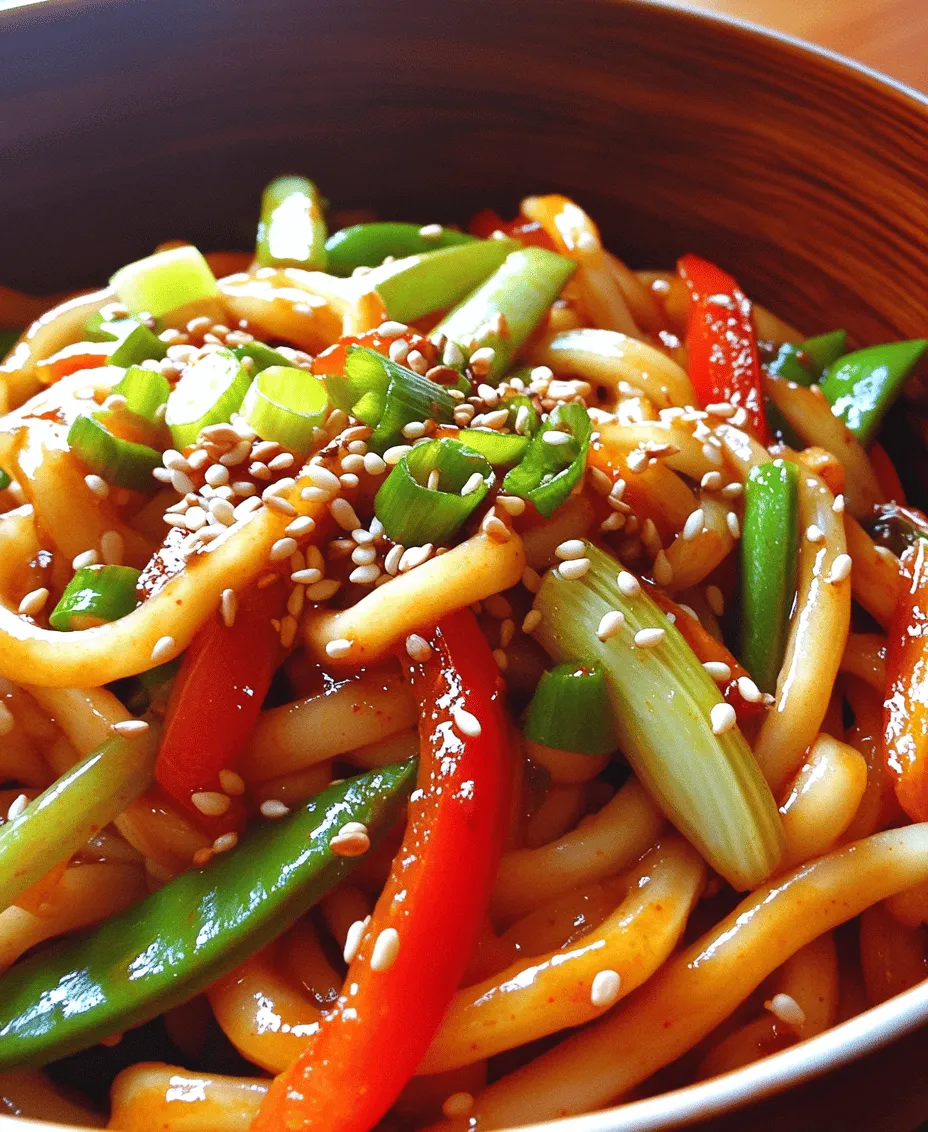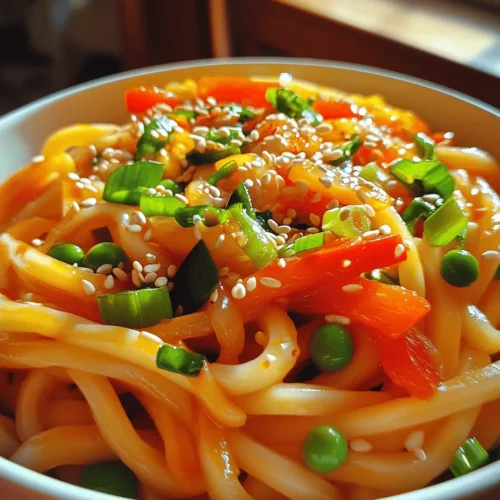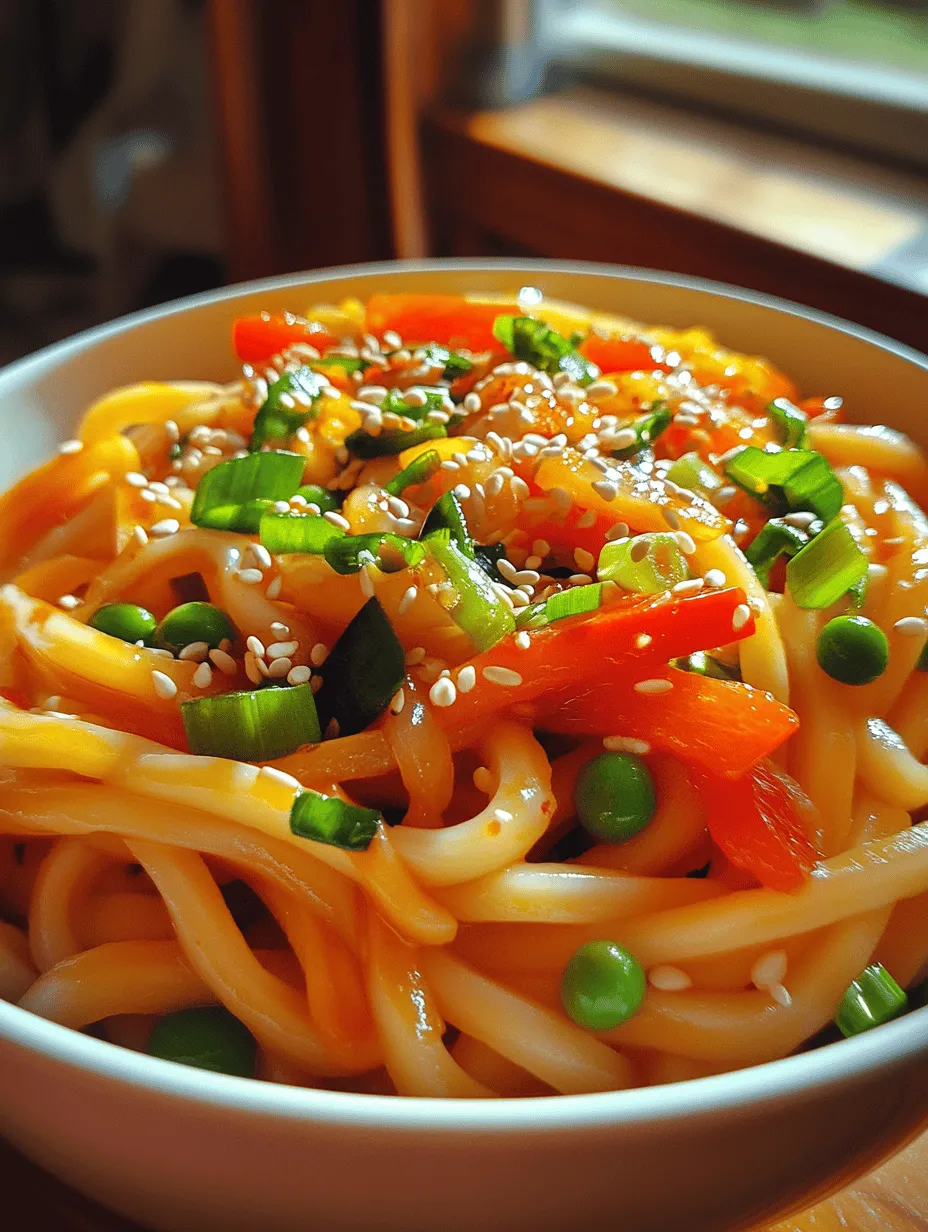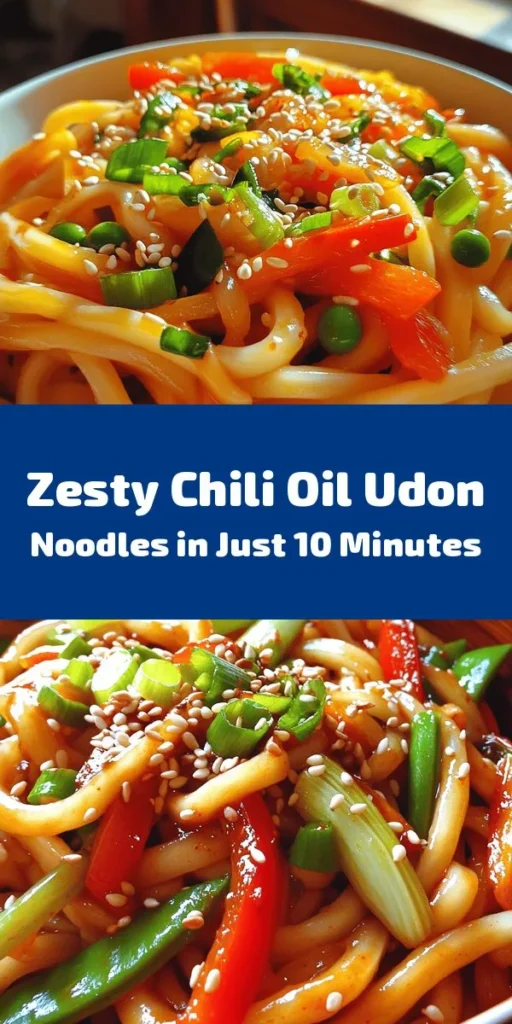Introduction to Quick & Zesty Chili Oil Udon Noodles
In recent years, Asian cuisine has captivated food enthusiasts around the globe, with dishes such as udon noodles rising to prominence in many households. Known for their chewy texture and ability to absorb flavors, udon noodles are a versatile staple that can be transformed into a variety of meals. If you’re on the hunt for a quick, flavorful dish that can be prepared in under 30 minutes, look no further than this Quick & Zesty Chili Oil Udon Noodles recipe. It marries the umami richness of soy sauce, the aromatic kick of chili oil, and the freshness of vegetables, making it not only a satisfying meal but also a delightful culinary experience suitable for any occasion.
This recipe is particularly ideal for busy professionals, students, or anyone simply wanting to whip up a delicious dinner in a snap. With its vibrant colors and bold flavors, this dish is sure to impress both family and friends. But beyond just being quick and easy, the combination of ingredients ensures a meal that’s rich in taste and nutrition.
Understanding Udon Noodles
What Are Udon Noodles?
Udon noodles are thick, chewy wheat noodles that harken back to their roots in Japan, where they have been enjoyed for centuries. Traditionally served in a savory broth or stir-fried with an array of ingredients, udon is beloved for its satisfying texture and ability to hold sauces and flavors beautifully.
Udon noodles come in various forms, including fresh, frozen, and dried. Fresh udon noodles are typically softer and cook more quickly, while dried varieties require a longer cooking time but are convenient to store. Some types of udon noodles may even come flavored with ingredients like green tea or sesame, adding an extra twist to your culinary creations.
Nutritional Benefits of Udon Noodles
Udon noodles are not just a delicious addition to your meal; they also pack a nutritional punch. As a carbohydrate-rich food, they provide a quick energy source, making them an ideal choice for anyone needing a boost throughout the day.
In addition to their carbohydrate content, udon noodles contain several essential vitamins and minerals, including B vitamins, iron, and magnesium. These nutrients are vital for various bodily functions, from energy production to bone health. When paired with a colorful array of vegetables and proteins, udon noodles can contribute to a balanced and nutritious meal.
Key Ingredients in Quick & Zesty Chili Oil Udon Noodles
Udon Noodles
When it comes to making Quick & Zesty Chili Oil Udon Noodles, the star of the show is undoubtedly the udon noodles themselves. Their unique texture allows them to soak up flavors, making each bite as delightful as the last. Cooking methods for udon vary, from boiling to stir-frying, giving you the flexibility to prepare them according to your preference.
In this recipe, we’ll be using fresh or pre-cooked udon noodles, which require minimal cooking time. Just a quick boil, and they’re ready to be tossed with your zesty chili oil and vegetables. The versatility of udon noodles means you can easily incorporate them into various dishes, whether you’re preparing a traditional soup or experimenting with a stir-fry.
The Flavor Power of Chili Oil
Chili oil is the secret ingredient that takes this udon noodle dish from ordinary to extraordinary. This versatile condiment is made by infusing oil with dried chili peppers, garlic, and other spices, resulting in a rich, aromatic oil that brings heat and depth to any dish.
There are several types of chili oil available, each with its own flavor profile. Some may be more aromatic, featuring notes of garlic or sesame, while others may pack a fiercer punch. In this recipe, we’ll be utilizing a well-balanced chili oil that adds a pleasant heat without overpowering the other ingredients.
Aside from enhancing flavors, chili oil also boasts several health benefits. It contains antioxidants and has anti-inflammatory properties, making it a popular choice for those looking to spice up their meals healthily.
Garlic: An Aromatic Essential
No dish is complete without garlic, and this recipe is no exception. Garlic not only adds an aromatic depth to the Quick & Zesty Chili Oil Udon Noodles but also brings a wealth of nutritional properties. Rich in vitamins C and B6, manganese, and selenium, garlic is known for its immune-boosting and anti-inflammatory benefits.
Incorporating garlic into your cooking can enhance the overall flavor profile of your dish, making each bite more enticing. In this recipe, freshly minced garlic will be sautéed in the chili oil, releasing its pungent aroma and creating a fragrant base for the udon noodles.
Importance of Soy Sauce
Soy sauce is another essential ingredient that elevates the umami flavor of this dish. With its salty and savory profile, soy sauce acts as a flavor enhancer, bringing all the elements together in perfect harmony. There are several types of soy sauce available, including light, dark, and tamari varieties, each bringing its unique taste and intensity to dishes.
For this Quick & Zesty Chili Oil Udon Noodles recipe, we’ll be using a combination of light and dark soy sauce. The light soy sauce adds a salty note, while the dark soy sauce contributes richness and color, ensuring a well-balanced flavor.
The Role of Sesame Oil and Rice Vinegar
To further enhance the flavor profile of your udon noodles, we’ll introduce sesame oil and rice vinegar. Sesame oil, with its nutty aroma, adds a layer of complexity and richness to the dish. It pairs beautifully with the heat of the chili oil and the savory notes of soy sauce.
Rice vinegar, on the other hand, introduces a subtle tanginess that brightens the overall flavor. This acidity helps balance the richness of the oil and the savory elements, creating a harmonious blend of flavors that will leave you craving more.
Mixed Vegetables: Fresh vs. Frozen
Adding a variety of vegetables not only boosts the nutritional value of your Quick & Zesty Chili Oil Udon Noodles but also introduces vibrant colors and textures. You can choose to use fresh vegetables like bell peppers, carrots, and bok choy, or opt for frozen mixed vegetables for a quicker option.
Fresh vegetables provide a crunch and vibrant taste, while frozen alternatives are convenient and often pre-washed and chopped, saving you valuable prep time. Whether you opt for fresh or frozen, both options will contribute a wealth of vitamins and minerals to your meal, making it more balanced and satisfying.
Optional Protein Choices
To make your udon noodle dish more filling, consider adding a protein source. Tofu, shrimp, and chicken are all excellent choices that not only enhance the flavor but also boost the nutritional profile of your meal.
Tofu is a fantastic plant-based option, rich in protein and essential amino acids. It absorbs flavors beautifully and adds a creamy texture. Shrimp provides a lean protein source and cooks quickly, making it a perfect addition to a fast-paced meal. For those who prefer meat, chicken is another option that can be easily sautéed and incorporated into the dish.
Whether you choose to include protein or keep it vegetarian, the Quick & Zesty Chili Oil Udon Noodles can easily be customized to suit your dietary preferences, making it a truly versatile recipe.
—
This foundational overview of Quick & Zesty Chili Oil Udon Noodles sets the stage for a delicious and quick meal. In the following sections, we’ll delve deeper into the step-by-step instructions for preparing this delightful dish, as well as tips for achieving the best results. Stay tuned to discover how to create an unforgettable udon noodle experience in your own kitchen.

Step-by-Step Instructions for Preparing Quick & Zesty Chili Oil Udon Noodles
Preparing the Udon Noodles
To start your culinary journey with Quick & Zesty Chili Oil Udon Noodles, the first step is to cook the udon noodles to perfection.
1. Boil Water: Fill a large pot with water and bring it to a rolling boil. It’s essential to have enough water to prevent the noodles from clumping.
2. Cook the Noodles: Add the udon noodles to the boiling water and cook according to the package instructions, usually around 8-12 minutes. For the best texture, taste them a minute or two before the time is up. They should be tender yet firm enough to hold their shape.
3. Rinse with Cold Water: Once cooked, drain the noodles in a colander and rinse them under cold water to stop the cooking process. This step also helps remove excess starch, ensuring your noodles remain separate and chewy.
4. Toss with Oil: Drizzle a small amount of sesame oil or vegetable oil over the rinsed noodles. Toss gently to coat, which will prevent them from sticking together.
Tips for Cooking Perfect Udon Noodles:
– Always use a large pot with plenty of water to avoid overcrowding the noodles.
– Stir occasionally during cooking to ensure even doneness.
– If you prefer a firmer noodle, reduce the cooking time slightly.
Sautéing the Garlic and Vegetables
Next, we move on to the aromatic base that elevates your udon noodles.
1. Heat Your Pan: In a large skillet or wok, heat 2 tablespoons of vegetable oil over medium-high heat. The oil should shimmer but not smoke.
2. Sauté Garlic: Add minced garlic (about 3-4 cloves) to the pan. Stir continuously for about 30 seconds until fragrant, being careful not to let it burn.
3. Add Vegetables: Toss in your choice of vegetables. Common options include bell peppers, carrots, and bok choy. Stir-fry for 3-4 minutes until they are just tender but still vibrant in color.
Best Practices for Stir-Frying:
– Cut your vegetables into uniform sizes to ensure even cooking.
– Don’t overcrowd the pan; if you have a lot of vegetables, consider cooking them in batches.
– Maintain high heat for a quick cook that preserves the vegetables’ crunch.
Combining Ingredients for Maximum Flavor
Now comes the magic of combining all the flavors.
1. Add Noodles to the Pan: Once your vegetables are cooked, add the prepared udon noodles to the skillet.
2. Drizzle Chili Oil: Pour in 2-3 tablespoons of your homemade or store-bought chili oil. Toss everything together, ensuring the noodles are well-coated with the oil and mingling with the vegetables.
3. Season: Sprinkle in soy sauce (2-3 tablespoons) and a dash of sesame oil. Toss again to distribute the flavors evenly.
Ensuring Even Distribution of Seasoning:
– Use tongs or chopsticks to mix the noodles and vegetables thoroughly, preventing any clumps.
– Taste before serving, adjusting the seasoning as needed. If you like it spicier, add more chili oil or a sprinkle of red pepper flakes.
Final Seasoning and Garnishing
Before serving, it’s time to perfect the dish.
1. Adjust Flavors: Taste your noodles and add more soy sauce or chili oil if needed. For a touch of sweetness, a teaspoon of sugar can balance the heat.
2. Garnishing: Plate the noodles and top with sliced green onions, sesame seeds, and perhaps a drizzle of extra chili oil for presentation.
How to Adjust Flavors to Personal Preference:
– Experiment with different types of soy sauce; dark soy sauce will add richness, while light soy sauce offers a saltier flavor.
– Fresh herbs like cilantro or basil can be used for a refreshing finish.
Serving Suggestions
Presentation is key when it comes to serving your Quick & Zesty Chili Oil Udon Noodles.
– Bowls: Serve the noodles in deep bowls to capture the sauce and toppings beautifully.
– Pair with Proteins: Consider adding toppings like grilled chicken, shrimp, or tofu to enhance the meal’s protein content.
– Accompaniments: Pair with a light side salad or steamed dumplings for a complete dinner experience.
Creative Ways to Present the Dish:
– Use colorful vegetables for vibrant contrast against the noodles.
– Serve with lime wedges on the side for an added zesty twist.
Variations of the Recipe
Vegetarian and Vegan Options
Adaptability is one of the strengths of the Quick & Zesty Chili Oil Udon Noodles, making it easy to cater to different dietary needs.
– Substitutions and Enhancements: For a vegetarian version, simply omit any meat and replace it with hearty vegetables like mushrooms or zucchini. If you want to boost flavor, consider adding miso paste or nutritional yeast for a cheesy taste.
Gluten-Free Alternatives
For those with gluten sensitivities, there are options to enjoy this dish without compromising taste.
– Recommended Gluten-Free Udon Options: Look for gluten-free udon noodles made from rice flour or other gluten-free grains. These noodles are widely available in specialty grocery stores or online.
Customizing Your Chili Oil Udon Noodles
Feel free to personalize this recipe to suit your taste preferences.
– Adding Unique Ingredients for a Personal Touch: Incorporate ingredients like kimchi for a tangy flavor, or add a spoonful of peanut butter for a rich, nutty sauce. You can also mix in different types of vegetables based on what you have on hand, like snap peas or baby corn.
Health Considerations
Balanced Meal Composition
This dish can be part of a balanced meal, offering a mix of carbohydrates, fats, and proteins.
– Understanding Macronutrients in the Recipe: The udon noodles provide carbohydrates, while the chili oil adds healthy fats. By adding vegetables and a protein source, you create a well-rounded meal.
Caloric Breakdown of the Dish
Understanding the caloric content helps with portion control and dietary planning.
– Portion Sizes and Serving Recommendations: A standard serving of this dish can range from 400-600 calories, depending on the amount of oil and toppings used. Adjust serving sizes based on individual dietary needs.
Dietary Restrictions and Modifications
This recipe can easily be adapted for various dietary needs.
– Adapting the Recipe for Common Allergies: For those with soy allergies, consider using coconut aminos as a soy sauce substitute. Ensure that any additional ingredients, like chili oil, do not contain allergens.
Conclusion
The Quick & Zesty Chili Oil Udon Noodles recipe encapsulates the essence of fast, flavorful cooking. With its vibrant ingredients and easy preparation, it stands out as a perfect weeknight meal that doesn’t compromise on taste or nutrition. Whether you’re enjoying a quiet dinner at home or impressing friends at a gathering, this dish is sure to satisfy. By understanding the components and techniques involved, you can create a delicious bowl of udon noodles that caters to your culinary preferences and dietary needs. Embrace the joy of cooking with this delightful recipe, and experience the wonderful flavors that come together in every bite.



